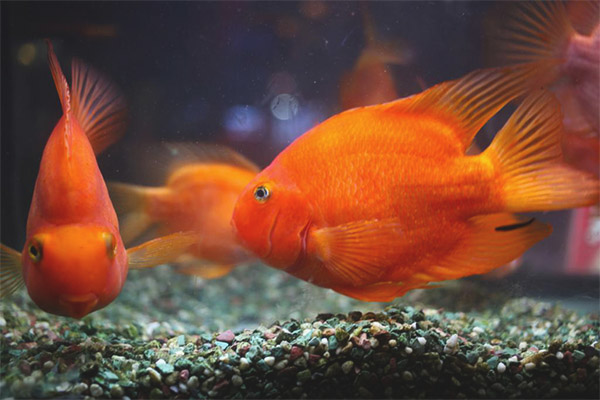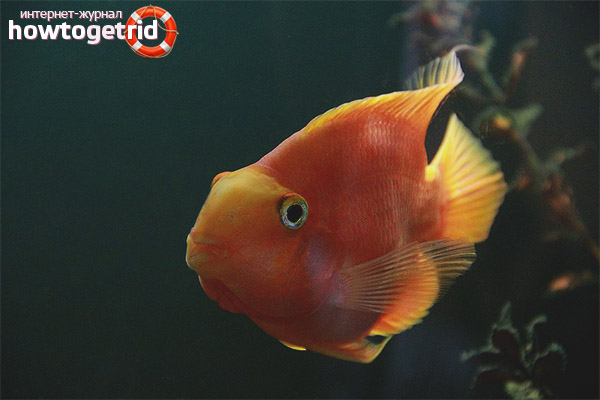The content of the article
Before acquiring an aquarium, an amateur or professional examines each species of fish in detail, then draws conclusions and prepares a home for them. Just 20 years ago, an interesting variety of aquatic creatures was bred, we are talking about parrot fish. The name comes from the interesting appearance of the pet. Front and side fish really resembles a grumpy feathered. Therefore, we can not pass by without affecting this species as future inhabitants of the aquarium.
Fish species and description
Before you go in search of the desired fish, you need to decide on its variety, because today there are several basic types. Naturally, they differ not only in appearance, but also in character.
Parrot fish is famous for its ridiculous manners, behaves like a cat.Let us explain: when the owner puts his hand into the aquarium, the fish literally begins to rub against the palm. She loves stroking, chatting.
To get such a unique breed, it took several years of hard work. South American cichlids took direct part in this. On their basis the parrot turned out. Otherwise, the fish are called sea elves. A distinctive feature is the mouth in the shape of the beak.
To date, there are 3 popular varieties, consider the characteristics of each of them in turn.
- Skar Differ in average size, pets grow in length by 19 cm. There are about 50 subspecies of scars. The most sought-after and beautiful are the following: guacamayya, striped belly, dark, striped silk belly. Under natural conditions, they prefer to dwell near coral reefs. In nature, they feed on some types of corals, as well as shellfish. In aquarium conditions they can eat everything, the main thing is to choose food, taking into account the breed.
- Red parrot The most popular type of aquatic pets from the family of parrots. From the name you can understand that the fish is red with yellow splashes.In length it grows up to 25 cm. It looks amazing in an aquarium. A distinctive feature is the presence of canines and incisors that protrude from under the lips. When a pet only matures, he is able to change color several times. In its natural environment, fish are lonely, live among corals. But they are good-natured with their neighbors when living in an aquarium. An interesting feature of red parrots is the fact that during a night's rest they wrap themselves in mucus, creating a cover for protection from external influences.
- Green cone. A water inhabitant in nature grows up to 1 m. With a weight of 35-40 kg. But the aquarium type of pets is much smaller. However, even against the background of all the others, he looks cumbersome and amazing. If the green parrot suddenly starts a quarrel, then it will end badly for the opponent. Its frontal part acts as a kind of ram. The fish picks up speed and literally blows the enemy. The attack looks skillful, so the neighborhood is chosen carefully.
Of course, you can meet the fish of this family in a different color. But we brought the most common and sought after species.In general, fish can be reddish, purple, pearl, blue, etc. You can meet pets with a beak of many colors.
Compatible with other fish
- It is necessary to immediately highlight the livability and goodwill of the family in relation to other species. Parrots are peace-loving, nimble, but can be calm. It all depends on the conditions of detention and temperament of individuals.
- Active parrots get along well with the same nimble fish that love to dig the soil and take part in the destruction of vegetation.
- It is better not to contain parrots with scalars, because water representatives with a beak pluck algae and, in general, treat them disparagingly. If at the time of the collapse of the vegetation an angelfish will hide in the thickets, a quarrel cannot be avoided.
- In any case, if you decide to bring as a fierce-minded fish as a neighbor, provide aquatic pets with an aquarium with enough water.
- It is strictly forbidden to keep parrots with small fish, otherwise scaly friends up to 5 cm in length will be mercilessly eaten.No need to tempt fate, all the trifle deposited in the second aquarium.
Maintenance and care
- These fish have a playful disposition, excellent intelligence, cunning, mobility and a tendency to attack. It is hard to believe, but such individuals really resemble ordinary parrots. If you decide to have a pair of such fish, you need to take care of a spacious aquarium.
- The volume of the tank should be about 200 liters. Not less. In the wild, such fish live in underwater coral reefs. Therefore, it is recommended to install a special pump in the aquarium. Without it, the inhabitants will feel uncomfortable. In addition, the fish can eat poorly.
- Consider, the water temperature should be within 24 degrees. Without fail, the water must be further enriched with oxygen. Constant aeration is simply necessary. Representatives of this species can live exclusively in running water. Change half of the water in the aquarium should be at least once a week.
- In addition, the aquarium should be covered with a grid. Otherwise, the fish can jump out without any problems.Such individuals do not need special decoration of the aquarium. Fish do not differ whimsical. It is enough to add small stones and soil to the tank. Fish used to tear the bottom with their beaks. In addition, it should be noted that it is the red parrots who love to build nests. Therefore, do not be surprised at what you see.
- It is highly recommended not to contain different types of fish that are used to using shelters. Because of this, conflicts may arise. Also, you should not have slow and sedentary fish in your tank. Otherwise, the parrots will constantly attack them.
- It is mandatory to have densely growing algae in the aquarium, 5 cm. Soil and all kinds of stone caves or coconut shells. Do not forget to enrich water with oxygen and regularly replace it. Systematically clean the aquarium. Such requirements are necessary for almost every type of fish.
Feeding
- If you care for fish you need to adhere to some rules, then there will be no questions with feeding. Parrots are completely unpretentious in food, regardless of the variety.Feed the fish several times a day. In this case, the portions should not be large.
- A few days after getting used to it, the fish begin to swim independently to the edge of the aquarium, demanding food if you are nearby. They eat such fish pellets, bloodworms, bread, vegetables and all sorts of herbal supplements. Individuals can also give preference to live foods and dry mixes.
- If you choose the right diet, to ensure proper care and maintenance, the fish can live with you up to 10 years. Such individuals are unique in themselves. You can watch them for a long time. They also quickly get used to the person. In a sense, you can even play with them. Such fish are smart enough.
Gender distinction
- Distinguishing between female and male is quite a complicated procedure. In appearance, the fish are practically no different. Until such time as the individuals reach puberty, they cannot be distinguished at all. After that you can see that the male is slightly larger than the female and has a brighter color. The weaker sex in this regard is noticeably inferior.
- Also, gender can be distinguished if you carefully consider the fins. In females, they are more round, in males opposite - pointed.Also noteworthy is the important fact that parrots find only one partner in their entire life. They stay together until the end. That is why it is not recommended to disconnect a couple.
Parrot fish are quite interesting representatives of the fish. They differ from their relatives by their unique temper and sharp mind. Such individuals become attached to man. Do not be afraid to lower your hand in the aquarium, the fish can play with you. Also do not forget about the timely care and the right content. Feed the fish quality food. Pamper them with various goodies.
Video: red parrot fish













To send